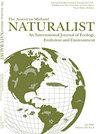白鼻综合征到来后肯塔基州东部森林中北方长耳蝙蝠的夏季种群
IF 0.6
4区 环境科学与生态学
Q4 Agricultural and Biological Sciences
引用次数: 0
摘要
摘要由于白鼻综合征(WNS),在北美东部的大部分分布地区,Myotis蝙蝠经历了重大的种群损失。作为封闭空间的觅食者,这些物种在东部森林中构成了一个重要的觅食行会。要充分评估Myotis蝙蝠的恢复潜力,需要了解夏季种群的分布以及它们在WNS影响下的生态变化。在2015年至2018年期间,我们利用声学采样、捕获调查、无线电遥测和栖息地调查来评估肯塔基州东部森林中北方长耳蝙蝠(Myotis septentrionalis)在WNS对该物种的区域性影响后的状况。肌炎蝠的声学活动在4个月的采样期间保持不变,在7月中下旬活动最活跃。北方长耳蝙蝠占捕获的Myotis的97%,表明活动水平可能反映了该物种的模式。我们在5种树种中找到了18棵北方长耳蝙蝠的栖息树,包括活树和死树。所有的栖息树都生长在离山脊公路100米以内的上坡上。在5月下旬和6月初,两个栖息地的最大出栏数分别为24只和21只,表明这些日期代表了该森林北部长耳蝠的夏季生育期。研究结果表明,罗宾逊森林的北方长耳蝙蝠在wns后形成了小群体,白天栖息在森林山脊顶部道路附近的树上,繁殖活跃,并在4年的采样期间保持稳定的活动水平。这些数据表明,当地的北方长耳蝙蝠种群在WNS中幸存下来,并在夏季的几个月里继续在阿巴拉契亚山区的森林中生存。我们假设,在积极管理的森林中,山脊顶部道路的存在可能是增加夏季北方长耳蝙蝠首选栖息地可用性的重要栖息地元素,这些道路通常与森林伐木作业有关。本文章由计算机程序翻译,如有差异,请以英文原文为准。
Summer Populations of Northern Long-eared Bat in an Eastern Kentucky Forest Following Arrival of White-nose Syndrome
Abstract. Myotis bats have experienced significant population losses due to white-nose syndrome (WNS) throughout large portions of their distributions in eastern North America. As closed-space foragers, these species comprise an important feeding guild within eastern forests. An understanding of where summer populations remain and how their ecology has changed following impact from WNS is needed to assess fully the recovery potential of Myotis bats. We used acoustic sampling, capture surveys, radiotelemetry and roost surveys from 2015 to 2018 to evaluate the status of northern long-eared bat (Myotis septentrionalis) in an eastern Kentucky forest following region-wide impacts from WNS to this species. Acoustic activity of Myotis remained unchanged over the 4 y of sampling, with activity of these bats greatest in mid- to late July. Northern long-eared bats represented 97% of the Myotis captured, indicating activity levels likely reflected patterns for this species. We located 18 roost trees of northern long-eared bats in five tree species, including both live and dead trees. All roost trees were on upper slopes within 100 m of ridge top roads. Maximum exit counts, 24 and 21, at two roosts occurred in late May and early June, suggesting these dates represented the summer maternity period of northern long-eared bats in this forest. Our results demonstrated that post-WNS populations of northern long-eared bats on Robinson Forest formed small colonies, day-roosted in trees near roads on forested ridge tops, were reproductively active, and maintained steady levels of activity across the 4 y of sampling. These data suggest that local populations of northern long-eared bats are surviving WNS and continue to persist during summer months in forests of the Appalachian Mountain region. We hypothesize presence of ridge top roads, often associated with forest logging operations, may be important habitat elements for increasing availability of preferred roosting habitat for summer populations of northern long-eared bats in actively managed forests.
求助全文
通过发布文献求助,成功后即可免费获取论文全文。
去求助
来源期刊

American Midland Naturalist
环境科学-生态学
CiteScore
1.20
自引率
0.00%
发文量
38
审稿时长
18-36 weeks
期刊介绍:
The American Midland Naturalist has been published for 90 years by the University of Notre Dame. The connotations of Midland and Naturalist have broadened and its geographic coverage now includes North America with occasional articles from other continents. The old image of naturalist has changed and the journal publishes what Charles Elton aptly termed "scientific natural history" including field and experimental biology. Its significance and breadth of coverage are evident in that the American Midland Naturalist is among the most frequently cited journals in publications on ecology, mammalogy, herpetology, ornithology, ichthyology, parasitology, aquatic and invertebrate biology and other biological disciplines.
 求助内容:
求助内容: 应助结果提醒方式:
应助结果提醒方式:


